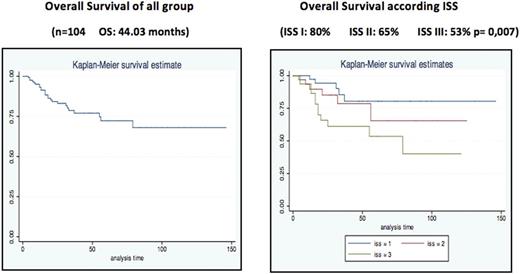Abstract
Introduction: Multiple Myeloma (MM) is characterized by a significant morbidity and mortality. Recent advances have improved knowledge of biology of MM, and incorporation of ASCT and novel treatments have transformed the natural history of MM, improving overall survival (OS). However, relatively little is known about the epidemiology and outcomes in developing countries such as Colombia.
Purpose: The aim of this study was to identify the clinical and pathological features and outcomes of MM patients in a Colombian reference center.
Methods: We reviewed the medical records of patients referred to Hospital Fundación Santa Fe, Colombia between January 1983 and June 2017, with previous approval by the Institutional Review Board. Newly diagnosed MM patients were retrospectively included in this study. Diagnoses were reviewed according to IMWG criteria. The records of all patients were revised; clinical information was collected and analyzed. Descriptive analysis was performed, and variables were correlated by Spearman´s coefficient. Survival analysis was performed by Kaplain Meier curves and a Cox coefficient model was performed using the variables ISS risk and transplants. Statistical association was considered for p values <0.05.
Results: A total of184 newly diagnosed MM patients were included, with median age of 66.5 years old (range 23-91 years), 3.7% were younger than 50 years old. There was not a difference between gender (female: 89; male: 95 patients). Patients were classified as ISS III and ISS II in the 33% and 31% of the cases, respectively. At diagnosis, leading symptoms were bone pain (48.8%) and fatigue (20%). Also, the patients presented hypercalcemia (11%) and renal impairment (20%). The whole blood count showed hemoglobin less than 10 mg/dl in 25.5% of patients and pancytopenia in 3.8%. Only 8.3% were diagnosed previously with MGUS and 8.3% had autoimmune disease, the most frequent was rheumatoid arthritis (26.6%). 33.15% had expositional factor history (tobacco smoking 83.6%), 9.2% had history of cancer (most frequently prostate cancer). 28.5% of patients referred have a first-degree relative with cancer, being the most frequent was breast cancer (32.7%).
The most frequent isotypes of immunoglobulins were IgG (59.74%), followed by IgA (25%). 16.8% were only light chain and 2.5% were non-secretory. Free light chain showed an abnormal ratio in the majority of patients (88.235%). The morphologic presence of circulating plasma cells was detected in 1.6% of patients and bone marrow aspirates showed a range of infiltration by MM between 10 to 93%. Flow Cytometry identified a median of tumor plasma cells of 15%.The most commonly aberrant antigen expression detected was CD19 (94.82%), CD45 (84.2%), CD56 (59.3%). There was a strong positive correlation between the measure of aspirate and flow cytometry (Spearman 70%; p=0.000). Only 13 patients were assessed with FISH and 3 had p53 deletion. All patients were analyzed with conventional radiography, allowing alterations identification in 77% of patients (75.2% with lytic lesions and 17% with fractures).
One hundred and four patients could be followed for more than 4 months, with a mean of 39.67 months and OS of all cohort was 44.03 months. The 5-year OS rate was 80% (CI95%=57.7-91.5) in ISS I, 65% (CI95%=31.6-85.4) in ISS II, and 53% (CI95%=29.8-72) in ISS III groups (Figure 1). 39.5 % received ASCT, their OS was 74% (CI95%= 52.4-87) versus 71% transplantation-ineligible patients (CI95%= 56.3-81.7). Cox regression model showed association between mortality and ISS (HR: 1.93; 95%CI: 1.15-3.24), but no association with transplant (HR: 0.73; 95%CI: 0.31-1.71). 35% died, the main cause of death was related to infectious processes.
Conclusions
This study showed that MM patients of a reference center of a developing country have similar clinical, immunological and pathological characteristics, as well as OS, stratified according ISS, compared to published data in developed countries. However, there was fewer number of patients that received ASCT, Therefore, it is important to work for improving its access and to develop new treatments for patients in developing countries.
No relevant conflicts of interest to declare.
Author notes
Asterisk with author names denotes non-ASH members.


This feature is available to Subscribers Only
Sign In or Create an Account Close Modal